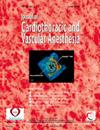缺血性心源性休克患者超声心动图测量的右心室收缩参数与肺动脉导管得出的卒中量之间的关系
IF 2.3
4区 医学
Q2 ANESTHESIOLOGY
Journal of cardiothoracic and vascular anesthesia
Pub Date : 2024-07-25
DOI:10.1053/j.jvca.2024.07.024
引用次数: 0
摘要
目的 通过肺动脉导管(PAC)热稀释法确定因ST段抬高型心肌梗死(STEMI)并发心源性休克(CS)而入住重症监护室的患者的右心室(RV)收缩功能超声心动图参数与原始每搏量(SV)的最佳相关性。干预措施同时收集全面的经胸超声心动图、临床和 PAC 衍生的血流动力学数据。中位患者年龄为 61 岁(四分位距 [IQR],52-67 岁),43 名患者中有 36 名男性(84%)。中位 PAC 导出 SV 和左心室射血分数分别为 57 mL(IQR,39-70 mL)和 31%(IQR,22%-35%)。RV 流出道速度时间积分(RVOT VTI)和三尖瓣平面收缩期偏移(TAPSE)与 PAC 导出 SV 显著相关(分别为 r = 0.42 [p = 0.007] 和 r = 0.37 [p = 0.02])。RVOT VTI 与 PAC 导出的低 SV 独立相关并可预测低 SV(几率比,1.3;p = 0.03),且曲线下面积良好(AUC = 0.71;p = 0.02)。RVOT VTI <12.7 cm 预测 PAC 导出的低 SV,敏感性为 66%,特异性为 72%。该参数有助于指导该组患者的血流动力学管理。本文章由计算机程序翻译,如有差异,请以英文原文为准。
Association Between Right Ventricular Systolic Parameters Measured by Echocardiography and Stroke Volume Derived From Pulmonary Artery Catheter in Ischemic Cardiogenic Shock
Objective
To determine the right ventricular (RV) systolic function echocardiographic parameter best associated with native stroke volume (SV) by thermodilution via a pulmonary artery catheter (PAC) in patients admitted to intensive care with ST elevation myocardial infarction (STEMI) complicated by cardiogenic shock (CS).
Design, Setting, and Participants
An observational cohort study of 43 prospectively identified patients admitted to a tertiary cardiac intensive care unit in London, United Kingdom.
Interventions
Simultaneous collection of comprehensive transthoracic echocardiographic, clinical, and PAC-derived hemodynamic data. Seven RV systolic function parameters were correlated with the PAC-derived SV.
Measurements and Main Results
The median patient age was 61 years (interquartile range [IQR], 52-67 years), and 36 of the 43 patients (84%) were male. The median PAC-derived SV and left ventricular ejection fraction were 57 mL (IQR, 39-70 mL) and 31% (IQR, 22%-35%), respectively. The RV outflow tract velocity time integral (RVOT VTI) and tricuspid plane systolic excursion (TAPSE) correlated significantly with the PAC-derived SV (r = 0.42 [p = 0.007] and r = 0.37 [p = 0.02], respectively). The RVOT VTI was independently associated with and predicted low PAC-derived SV (odds ratio, 1.3; p = 0.03) with a good area under the curve (AUC = 0.71; p = 0.02). An RVOT VTI <12.7 cm predicted low PAC-derived SV with a sensitivity of 66% and specificity of 72%.
Conclusions
RVOT VTI is the echocardiographic RV systolic function parameter that best correlates with PAC-derived native SV in patients with STEMI complicated by CS. This parameter can help guide the hemodynamic management of this cohort.
求助全文
通过发布文献求助,成功后即可免费获取论文全文。
去求助
来源期刊
CiteScore
4.80
自引率
17.90%
发文量
606
审稿时长
37 days
期刊介绍:
The Journal of Cardiothoracic and Vascular Anesthesia is primarily aimed at anesthesiologists who deal with patients undergoing cardiac, thoracic or vascular surgical procedures. JCVA features a multidisciplinary approach, with contributions from cardiac, vascular and thoracic surgeons, cardiologists, and other related specialists. Emphasis is placed on rapid publication of clinically relevant material.

 求助内容:
求助内容: 应助结果提醒方式:
应助结果提醒方式:


